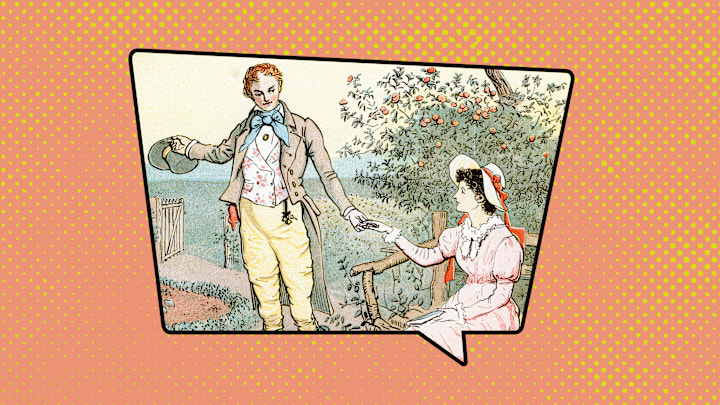The only thing more rewarding than receiving a fine compliment is doling one out. Here are a few charming, cute, and kooky kudos from the days of yore dating back through the past seven centuries, all sure to land you in good favor with those on the receiving end. (And if you’re in need of old-timey insults, we have those too.)
1. Bellibone
Even 400 years ago there were instances of delicacy: Romantic knights, well-read royals, and love-struck troubadours all knew their way around some fancy words. For instance, we have bellibone, a delightful term for a lady rich in personality as well as physical beauty.
2. Peerless Paramour
If you’re looking for a bit of Middle Ages jargon that feels a little more romantic, this phrase denoting unbeatable affection is the way to go.
3. and 4. Truepenny and Straight-Up

During the 16th century, honesty became a characteristic of newfound acclaim in the English language. If you happen upon someone whose trustworthiness cannot go without commendation, try using truepenny or straight-up to compliment them.
5. Bawcock
While the Medieval and early Elizabethan periods boasted plenty of colorful colloquialisms, you’ll no doubt want to advance to the height of William Shakespeare’s career to get some of the really good stuff. This term for a gentleman of character and integrity, for instance, is pretty hard to beat.
6. Wag
If you spend your time among particularly humorous company, this diminutive designation will come in handy. After your funniest friend earns a particularly big laugh, champion him or her as the group’s beloved wag.
7. Liquorous Rolling Eyes

In the mid-17th century, someone—possibly English author John “J.G.” Gough—made a living off the art of niceties by publishing The Academy of Complements, in which he offers a wide variety of options for laying some charm on a romantic partner. Along with liquorous rolling eyes, Gough included compliments like “her breath doth sent of Amber” and “her lips are rubies of an infinite value.”
8. Bully
This is a bit of a confusing one, considering the word’s modern, negative connotation—but originally, bully was a 16th-century term of endearment. (According to the OED, it may be derived from the Dutch word boel, which was used for friends and companions.) You’ll probably want to explain to your friend that you’re intending to point out his good nature and strong moral fiber before calling him a ”bully.”
9. Fairhead
Say you just caught a glimpse of an attractive stranger across the room—this assessment of him or her as one brimming with physical allure should win you due favor.
10. Your Virtues Have So Strangely Taken Up My Thoughts
The New Academy of Complements, published in the 18th century, offered some long-winded gems: “Your virtues have so strangely taken up my thoughts, that therein they encrease and multiply in abundant felicity,” and “As you are fair and beauteous, be generous and merciful to him that is your slave.”
11. Bricky

Bricky is an adjective you can use to laud a friend for his or her reliability, likening the tough and unyielding nature of the party in question to—what else?—a brick.
12. Jammiest Bits of Jam
Granted, it sounds a bit like a compliment you’d pay to a nice piece of toast, but this old slang superlative actually signifies “perfect young females.”
13. Pippin
When pippin first popped up in the 17th century, it was a term for a young, naïve person; later, it came to be used as a term for a person of high esteem and admiration. Granted, it’s also a type of apple, but context clues should clear things up in conversational use.
14. Snuggery
It’s always appropriate to pay notice to a friend’s living quarters when stopping by, too. If a warm, cozy, or otherwise pleasant little abode wins your notice, make sure to remark on what a fine snuggery your chum has managed to land.
15. Elephant’s Adenoids

All of these words and phrases are great, but what need have you for any other compliment when you can tap into the wide variety of zoological possessive couplets that earned popularity in the 1920s? You’ve got your choice of caterpillar’s kimono, bullfrog’s beard, clam’s garter, eel’s ankle, sardine’s whiskers, and butterfly’s book—and our favorite, elephant’s adenoids.
16. Lummy
Charles Dickens coined this term in 1838’s Oliver Twist to refer to someone who is smart and attractive.
A version of this story ran in 2015; it has been updated for 2023.
Are you a logophile? Do you want to learn unusual words and old-timey slang to make conversation more interesting, or discover fascinating tidbits about the origins of everyday phrases? Then get our new book, The Curious Compendium of Wonderful Words: A Miscellany of Obscure Terms, Bizarre Phrases, & Surprising Etymologies, out now! You can pick up your copy on Amazon, Barnes & Noble, Books-A-Million, or Bookshop.org.
